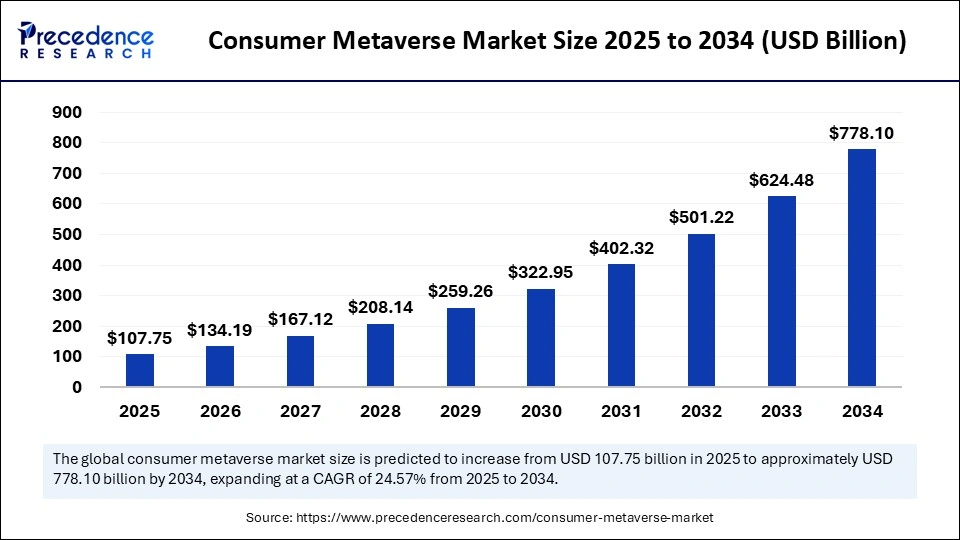The global consumer metaverse market is poised for explosive growth, projected to expand from USD 107.75 billion in 2025 to an astonishing USD 778.10 billion by 2034, registering a robust compound annual growth rate (CAGR) of 24.57%. This rapid surge is driven by increasing demand for immersive digital experiences that blend entertainment, social interactions, and virtual commerce, reshaping how consumers engage online.

Consumer Metaverse Market Key Points
- The market size reached USD 86.53 billion in 2024 and is expected to jump to USD 107.75 billion in 2025.
-
North America currently dominates the market, supported by advanced 5G infrastructure and widespread use of AR/VR platforms.
-
Asia Pacific is the fastest-growing region, powered by escalating smartphone adoption and government initiatives promoting digital innovation.
-
Mobile devices remain the leading access mode due to widespread availability and affordability, with AR glasses and wearables rapidly gaining traction.
-
The gaming and esports segment leads application revenue, while virtual commerce and marketplaces represent the fastest-growing use cases.
-
Virtual goods and microtransactions dominate monetization, but NFT/token sales and royalties are emerging as the most profitable revenue streams.
-
Casual users form the largest consumer base, while the creator segment is growing due to content monetization opportunities.
AI’s Role in Shaping the Consumer Metaverse Market
Artificial intelligence is revolutionizing the consumer metaverse by powering more lifelike, expressive avatars and immersive interactions. AI enables avatars to accurately mimic human gestures, speech, and facial expressions, reducing the uncanny valley effect and enhancing user engagement. This evolution expands use cases beyond entertainment and gaming to include customer service avatars, virtual events, and social gatherings. Furthermore, AI allows users to customize their avatars with simple text or image inputs, broadening user personalization and driving sales of virtual accessories.
AI also accelerates content moderation, user experience personalization, and virtual environment adaptability, positioning the metaverse as an increasingly interactive and user-centric digital ecosystem. These AI-driven capabilities are crucial to attracting new users, fostering prolonged engagement, and unlocking fresh revenue channels.
Get this report to explore global market size, share, CAGR, and trends, featuring detailed segmental analysis and an insightful competitive landscape overview @ https://www.precedenceresearch.com/sample/6805
Consumer Metaverse Market Growth Factors
Key growth drivers include continuous advancements in AR/VR hardware that lower costs and enhance usability, making immersive experiences more accessible. The proliferation of 5G and improvements in cloud infrastructure enable seamless, low-latency metaverse interactions. Increasing investments by tech giants in scalable, interactive ecosystems further stimulate market expansion. Additionally, the rise of remote lifestyles and vibrant social gaming communities are accelerating adoption.
Opportunity and Trend Exploration
Why are mobile devices the dominant access mode in the consumer metaverse market?
Mobile devices dominate due to their accessibility, low cost, and user-friendly interfaces, making them the primary entry point for most users globally. The integration of augmented reality capabilities into smartphones enhances immersive experiences further, a trend expected to strengthen with expanding 5G networks.
What is driving the rapid growth of AR glasses and wearable devices?
AR glasses and wearables offer hands-free, immersive experiences blending virtual and real worlds. Significant investments by leading companies such as Apple and Meta aim to make these devices mainstream, promising seamless virtual integration into daily life through continued miniaturization and better battery tech.
Why are gaming and esports paramount in metaverse applications?
Gaming and esports create engaging, interactive virtual environments with vibrant social interaction. Platforms like Fortnite and Roblox foster creator economies where users develop content and monetize experiences, fueling robust market activity and innovation.
What monetization models lead in the consumer metaverse?
Virtual goods and microtransactions currently dominate as users purchase avatar customizations and digital assets. Simultaneously, NFT and token sales are emerging as financially lucrative due to their rarity and royalty potentials, supported by blockchain-backed secure transactions.
How are consumer segments evolving in the metaverse?
Casual users lead market adoption owing to simple, recreational platform designs emphasizing social and entertainment value. Meanwhile, content creators gain traction by leveraging sophisticated marketplaces and tools for virtual commerce, driving innovation and engagement.
Consumer Metaverse Market Regional and Segmentation Analysis
North America leads due to established AR/VR ecosystems, robust 5G infrastructure, and strong consumer engagement, anchored by major tech investments. Asia Pacific emerges as the fastest-growing region with rapid smartphone penetration, government digitalization initiatives, and a burgeoning creator economy driving market expansion. Europe, Latin America, and the Middle East & Africa contribute to steady growth with increasing adoption of virtual commerce and social metaverse platforms.
The market is segmented by device/access mode (mobile devices, AR glasses/wearables), application/use case (gaming & esports, virtual commerce), monetization model (virtual goods, NFTs), end-user type (casual users, creators), distribution channel (platform stores, creator marketplaces), and region.
Latest Breakthroughs and Key Players
Leading companies making strides include Apple, Meta Platforms, Fortnite developer Epic Games, Roblox Corporation, and various blockchain platforms facilitating NFTs and virtual marketplaces. Advancements in AR hardware, AI-powered avatars, and virtual commerce integrations are spearheading innovation, supporting sustained market growth.
Challenges and Cost Pressures
Despite advancements, high costs of advanced AR/VR hardware and GPUs restrict mass consumer access, creating a digital divide. Affordability issues are pronounced in emerging markets. Furthermore, uneven global internet connectivity and the need for low-latency networks impede seamless metaverse experience and scalability.
Case Study: Virtual Commerce Expansion
A leading virtual fashion brand launched limited edition NFT skins and avatar accessories across platforms like Roblox, achieving a 150% growth in digital sales within six months. This success underscores how blockchain-secured assets and immersive virtual retail drive new revenue streams and deepen consumer engagement.
Read Also: Serverless Computing Market
You can place an order or ask any questions. Please feel free to contact us at sales@precedenceresearch.com |+1 804 441 9344
- Consumer Metaverse Market Size to Cross USD 778.10 Billion by 2034 - September 19, 2025
- Space On Board Computing Platform Market Size to Surpass USD 4.79 Bn by 2034 - September 19, 2025
- Virtual Commissioning Market Size to Reach USD 4.86 Billion by 2034 - September 19, 2025
